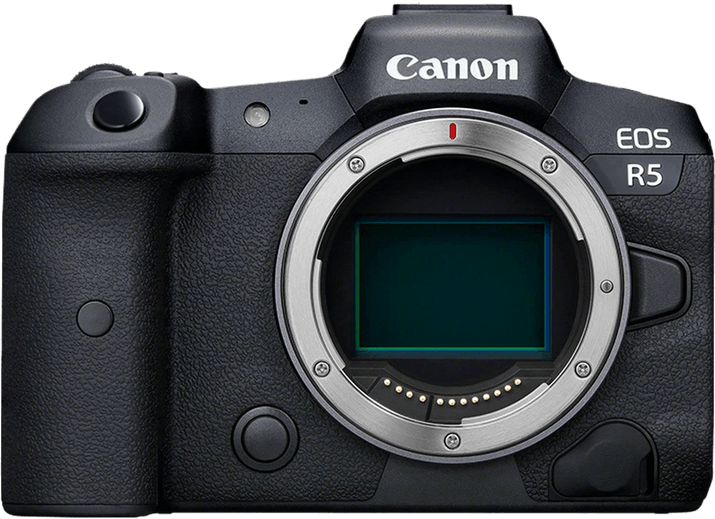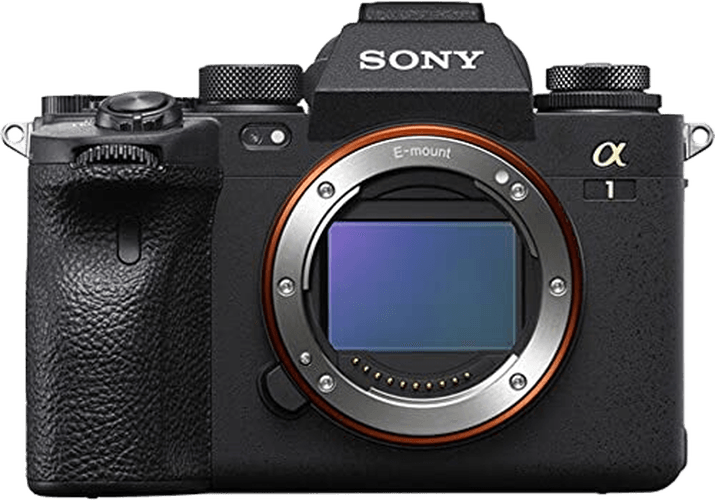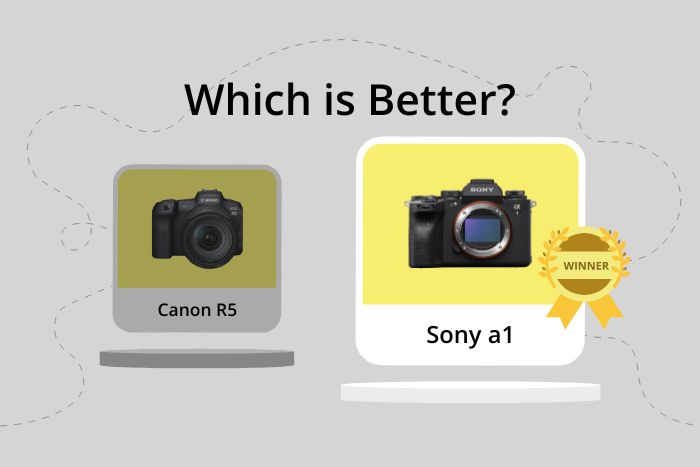Canon EOS R5 vs Sony a1 Comparison
Canon EOS R5

Sony a1

Sony a1 vs Canon R5 Overview
I’m a wildlife photographer. And in October 2021, I decided to replace my Nikon D810 and D850 DSLRs with a pair of mirrorless cameras.
All the major manufacturers now have a flagship mirrorless model. Sony has the a1, Canon has the EOS R5, and Nikon has the Z9. However, the Z9 wasn’t available then, so it was Sony a1 vs Canon R5.
After reading dozens of reviews and watching a few YouTube videos comparing the autofocus systems, I decided to buy a pair of Sony a1s. I thought they were the best cameras for wildlife photography at the time. And I haven’t changed my mind after using them extensively on shoots in Canada, Antarctica, Kenya, and Botswana.

Body and Handling
The Canon R5 is the Ferrari of cameras with its smooth curves and organic styling. The Sony a1 is more like a Lamborghini. Yes, there are more flat panels and sharp angles. But I still take a Diablo over a 455 any day!
The cameras are broadly similar in size and weight. However, the R5 has a slightly larger and fully articulated rear screen. The a1’s LCD only tilts up and down.
The a1 does better with its electronic viewfinder’s (EVF) resolution, magnification, and refresh rate. It’s the brightest, clearest, and most “realistic” of any mirrorless camera on the market.
I also found that the toggle lock switch on my a1’s Exposure Compensation dial got stuck sometimes. It’s a sign of poor build quality.
Sony a1 vs Canon R5 Optics
As you can see below, this is where the a1 performs slightly better than the R5.
Sensors and Color
Canon’s image quality on its full frame cameras has always been good. And the R5 is no exception. It also has a slightly higher dynamic range.
The Sony a1’s BSI (back-side illuminated) CMOS sensor gives it the advantage in low-light conditions. The a1’s extra 5MP is handy if you like to crop your images. But it isn’t a significant difference.
There is a problem with sensor spots on the a1, though. When I was in Africa recently, I had to clean the sensor three times in three weeks, which was irritating. The R5 doesn’t have that problem.
But both sensors are excellent. Your personal preference will probably be based on the color rendition.
Canon users will typically be used to “Canon color.” So it might be a bit of a shock if you switch to Sony—especially if you do a lot of portrait work.
It’s possible to “fix” the problem by choosing a different Adobe picture profile, for instance. But it can be annoying.
Frame Rates, AF, and Shutter Speed
The RAW frame rate of 30 fps is phenomenal—even if it’s only possible in the lossy compressed format. It might seem like overkill, but animals and birds can move a long way in a fraction of a second!
Regarding autofocus systems, both cameras offer market-leading eye detection and tracking. Plus, both have blackout-free shooting.
The a1’s autofocus system is the main reason I bought it. It’s quite astonishing to watch the little green square in the EVF lock on to a bird’s eye and follow it wherever it goes in the frame.
My only complaint is that you must choose between human, animal, or bird eye-tracking on the a1. Having to toggle between them is a waste of time. And it’s easy to end up in the wrong setting.
The R5 has far more phase-detection points than the a1. They cover 100% of the image area vs just 92%. The Canon Dual Pixel CMOS AF system also works better in low light (-6EV vs -4EV).
Finally, both cameras have a maximum shutter speed of 1/8000 s when using the mechanical shutter. However, the a1 can reach 1/32,000 s with the electronic shutter. And it has no problem with rolling shutter.

Sony a1
Canon EOS R5 vs Sony a1 Video Performance
The only time I recorded a video clip on my a1, I lost it! Video clips end up in a different folder than still images. And I had formatted the memory card before I realized it was missing!
Little details like that are annoying. But there’s certainly no problem with the video capabilities of either the Sony a1 or the Canon R5.
Both can shoot 8K Ultra HD video. The differences in protocols and bit rates are only for the initiated!
The advantage of the R5 is that it offers slightly better video resolution. Plus, it can record 12-bit RAW internally.
On the other hand, the a1 can shoot for longer without overheating. And it’s capable of 16-bit HDMI output as opposed to 4K / 60p.
Canon EOS R5 vs Sony a1 Features and Benefits
After using the a1 extensively in the field, my main gripe is it has sometimes stopped working for no clear reason. I later found out that I knocked a switch to the off position or used the wrong custom preset… it’s was a bit disconcerting!
I’m not sure the R5 would be any better. There are so many buttons, switches, and dials on modern cameras. So it’s easy to end up with the wrong settings by mistake.
Both models protect the sensor when changing lenses—although, annoyingly, not when silent shooting on the Sony a1. You must set up a custom button to toggle it on and off!
Customization
Looking at the positives, the joy of the a1 is that it’s extremely customizable. There are several custom and function buttons. The main mode dial even has three numbered custom presets. These are ideal for switching between different types of shots.
I have mine set up for wildlife portraits, birds in flight, and slow pans. Sony could only improve this if they didn’t lock the dial. It isn’t easy to unlock it and choose a different setting while looking through the viewfinder!
The R5 has similar customization options. But it doesn’t have the main command dial. Instead, there’s a Mode button with a Quick Control Dial and an LCD screen on top.
Sony’s menus used to be notoriously complicated and poorly laid out. However, the current version is as easy to use as the R5’s. The touchscreen capability helps.
Canon EOS R5 vs Sony a1 Storage and Battery
Most cameras involve compromises between major features. However, Sony and Canon have managed to develop two cameras that can pretty much do everything!
One of the few compromises of the a1 is that it only supports SD UHS-I/II and CFexpress Type A cards. That each slot can take both is a useful feature. The problem is that CFexpress Type A cards are much slower than Type B cards.
Type A is the Sony-backed format. But the read and write speeds are only 800 and 700 mbps, whereas the Type B cards supported by the R5 can manage 1400 and 1700 mbps!
Yes, the a1’s shooting buffer—155 compressed RAW images vs 238 RAW files—is better than the R5’s. But speed is king. So it’s a shame Sony backed the wrong horse.
When it comes to battery life, it’s worth taking the official CIPA measurements with a pinch of salt. Officially, my a1 camera can only take 430 pictures using the EVF on a single battery charge. But in Botswana, I happily filled three memory cards with over 6,000 images of little bee-eaters (birds)!
Why such a difference? It all comes down to the way you take pictures. If you take single shots, you might only take a few hundred. But most photographers shoot continuously. That means the camera is much less power-hungry.
I’m sure it’s the same with the R5. Officially, it’s rated at 320 shots per charge. But I’m sure you can get more by shooting in a continuous mode.
Just be wary of cold conditions. It tends to reduce battery life. I had real problems with my batteries shooting polar bears in Canada, with temperatures as low as -13 F (-25 C)!

Canon EOS R5 vs Sony a1 – Our Verdict
In Sony a1 vs Canon r5, these two cameras are the flagship mirrorless products for Canon and Sony. So you won’t go far wrong buying either of them.
If you’re a Canon DSLR owner, you might be tempted to choose the R5 and use your existing lenses. But you’d have to use an adapter, and the performance would be affected.
You need native lenses from the Canon’s EF range or Sony’s G Master series to get the best out of either camera. That’s why I traded in all my Nikon equipment when I moved to mirrorless. It was expensive but worth it!
The final remaining issue is the price. The R5 is a lot cheaper than the a1. That’s fine if you’re happy with a lower frame rate and smaller sensor. Otherwise, if money is no object, the Sony a1 remains the better choice.

Sony a1
Sony a1 vs Canon R5 Alternatives
Still not sure which camera is best for you? Check out our other popular camera comparisons:

